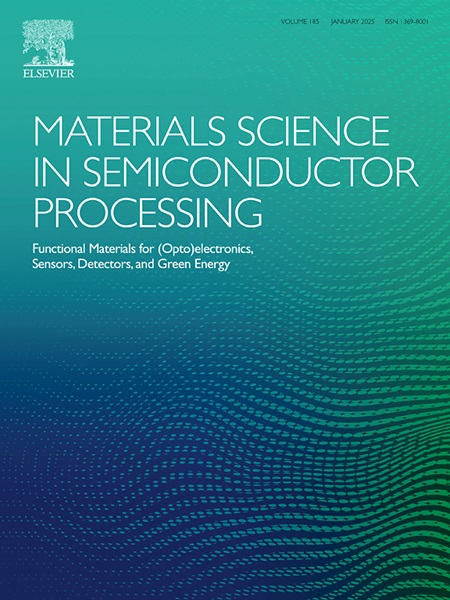引入氧氧化镁层改善Al/NiO肖特基势垒二极管的性能
IF 4.2
3区 工程技术
Q2 ENGINEERING, ELECTRICAL & ELECTRONIC
引用次数: 0
摘要
采用溅射的方法在Al和NiO之间插入不含氧和含氧的氧化镁(MgO)薄膜,以提高Al/NiO肖特基势垒二极管(sdd)的性能。未插入MgO的sdd (Al/NiO)显示出非整流I-V曲线。Al/MgO/NiO插入的sdd显著抑制了泄漏电流。然而,没有引入氧MgO的Al/MgO/NiO sbd仍然表现出非整流的I-V特性。然而,与Al/NiO sbd相比,引入氧MgO的Al/MgO/NiO sbd的泄漏电流降低了约5168倍。同时,引入氧MgO的Al/MgO/NiO sbd具有良好的整流性能,整流比为145。Al/NiO sdd的肖特基势垒高度(SBH)较低,为0.69 eV。在Al/MgO/NiO中加入未引入氧的MgO后,SBH提高到0.78 eV。引入氧后,Al/MgO/NiO sbd的SBH进一步提高到0.94 eV。引入氧的Al/MgO/NiO sbd漏电流小、SBH大的原因是由于MgO中的缺陷得到了补偿。在MgO溅射过程中引入的氧原子补偿了MgO的氧空位,从而减少了缺陷。采用Ln(I) - Ln(V)图研究载流子输运机制。在没有引入氧的情况下,Al/NiO和Al/MgO/NiO sdd中只观察到一个欧姆输运区,即空穴通过NiO和MgO的表面缺陷从NiO隧穿到Al。相比之下,在引入氧的Al/MgO/NiO sdd中观察到两个不同的输运区。对于V <;0.8 V时,输运以扩散隧穿为主。而无陷阱的空间电荷限制电流控制了V >的输运;0.8 V;在这里,NiO注入的孔洞占据了大部分的MgO陷阱,从而阻碍了孔洞的进一步注入。本文章由计算机程序翻译,如有差异,请以英文原文为准。
Improving the performance of Al/NiO Schottky-barrier diodes by inserting an introduced-oxygen MgO layer
Magnesium oxide (MgO) thin film without and with introduced oxygen was inserted between Al and nickel oxide (NiO) via a sputtering method to improve the performance of Al/NiO Schottky barrier diodes (SBDs). The SBDs without MgO insertion, Al/NiO, revealed a non-rectifying I-V curve. SBDs with MgO insertion, Al/MgO/NiO, significantly suppressed the leakage current. However, the Al/MgO/NiO SBDs without the introduced-oxygen MgO still exhibited a non-rectifying I-V characteristic. Nevertheless, the Al/MgO/NiO SBDs with the introduced-oxygen MgO reduced the leakage current by approximately 5168 times compared to the Al/NiO SBDs. Simultaneously, the Al/MgO/NiO SBDs with the introduced-oxygen MgO appeared a good rectifying behaviour having a rectification ratio of 145. A low Schottky-barrier height (SBH) of 0.69 eV was observed in Al/NiO SBDs. After insertion of MgO without introduced oxygen, the SBH was raised to 0.78 eV in Al/MgO/NiO. The SBH was further increased to 0.94 eV in the Al/MgO/NiO SBDs with introduced oxygen. The reason of less leakage current and large SBH in the Al/MgO/NiO SBDs with introduced oxygen is caused by that the compensated defects in MgO. The introduced oxygen atoms during MgO sputtering compensated for the oxygen vacancies of MgO and hence less defects. A Ln(I) versus Ln(V) plot was used to study carrier transport mechanisms. Only one region of ohmic transport was observed in Al/NiO and Al/MgO/NiO SBDs without introduced oxygen, where holes tunnelled from NiO to Al through the surface defects of NiO and MgO. In contrast, two distinct transport regions were observed in Al/MgO/NiO SBDs with introduced oxygen. For V < 0.8 V, diffusion-tunnelling dominated the transport. However, the trap-free space-charge-limited current controlled the transport at V > 0.8 V; here, the injected holes from NiO occupies most of the MgO traps, and thus hindered the further injection of holes.
求助全文
通过发布文献求助,成功后即可免费获取论文全文。
去求助
来源期刊

Materials Science in Semiconductor Processing
工程技术-材料科学:综合
CiteScore
8.00
自引率
4.90%
发文量
780
审稿时长
42 days
期刊介绍:
Materials Science in Semiconductor Processing provides a unique forum for the discussion of novel processing, applications and theoretical studies of functional materials and devices for (opto)electronics, sensors, detectors, biotechnology and green energy.
Each issue will aim to provide a snapshot of current insights, new achievements, breakthroughs and future trends in such diverse fields as microelectronics, energy conversion and storage, communications, biotechnology, (photo)catalysis, nano- and thin-film technology, hybrid and composite materials, chemical processing, vapor-phase deposition, device fabrication, and modelling, which are the backbone of advanced semiconductor processing and applications.
Coverage will include: advanced lithography for submicron devices; etching and related topics; ion implantation; damage evolution and related issues; plasma and thermal CVD; rapid thermal processing; advanced metallization and interconnect schemes; thin dielectric layers, oxidation; sol-gel processing; chemical bath and (electro)chemical deposition; compound semiconductor processing; new non-oxide materials and their applications; (macro)molecular and hybrid materials; molecular dynamics, ab-initio methods, Monte Carlo, etc.; new materials and processes for discrete and integrated circuits; magnetic materials and spintronics; heterostructures and quantum devices; engineering of the electrical and optical properties of semiconductors; crystal growth mechanisms; reliability, defect density, intrinsic impurities and defects.
 求助内容:
求助内容: 应助结果提醒方式:
应助结果提醒方式:


